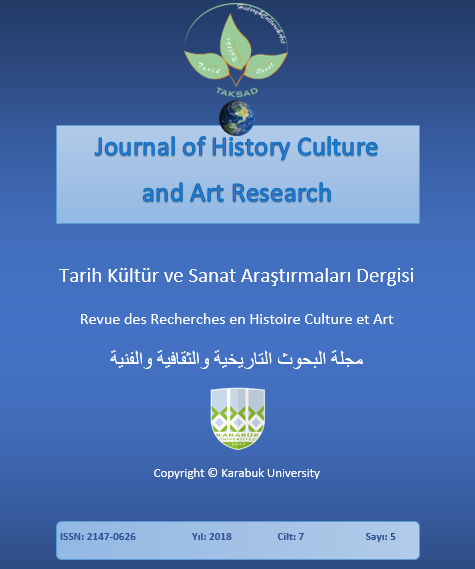Tuvinian Fairytales Based on the Mongol Story Plots: “Magic Dead Man” Collection of Short Stories
DOI:
https://doi.org/10.7596/taksad.v7i5.1914Keywords:
Tuva, Mongolia, Literary folklore traditions, Tuvinian folklore, Fairytales, Ancient Mongolian literature, Collection of stories, Framed novelette genre, Magic Dead Man.Abstract
In the course of historical development, cultural contacts of the Tuvinian people with the Mongol-speaking peoples were very diverse and intensive. Tuvinian-Mongol folklore literature contacts, which are one aspect of close cultural interactions of the peoples of Central Asia and Sayan-Altai regions, are of a great interest for researchers. One of the most prominent phenomena in the Tuvinian-Mongol folklore interrelations is a wide range of Central Asian versions of the Geser, Dzhangar, Khan-Kharanguy and other series of epic tales, along with various collections of Old Mongolian literature stories, which added a new plot and creative stylistic content and new genre form, the framed fairy tale, to the Tuvinian folklore.
Thus, in Tuvinian folklore, there were common plots adopted from the Mongolian literature in the framed novelette genre – Arzhi-Bordzhi, The Magic Dead Man, The Tales of a Parrot as well as Bigarmidzhid and Panchatantra, which, due to an active dispersion of Buddhism at the end of the 18th – the beginning of the 19th century began to spread in Tuva and Tuvinian folklore in fairytale form together with the religious literature.
The theoretical and methodological basis of the given research is structured around the works of leading experts in oriental, literature and folklore studies. A great contribution into the study of intercultural literary connections and folklore literature interconnections of the oriental people was made by E.M. Meletinsky, I.D. Serebryakov, P.A. Grintser, S.U. Nekludov, A.D. Tsendina, E.N. Afanasyeva and other researchers in the works and articles.
The aim of this research is to define the role and importance of Mongolian literary monument “Magic Dead Man” (Mong.: Shiditu hūr) in the expansion of Tuvinian folklore repertoire and enriching its plot and motif components as well as the introduction of a new genre form in the Tuvinian folklore – the framed fairytale, which comes from the genre of a framed novelette, which was created within the Ancient Indian literary tradition. The study was held on the complex approach level with the implementation of the comparative-typological and comparative-textological methods, which allowed completing a systematic analysis of the literary and folklore poetic and stylistic models. The Tuvianian storytelling tradition, based on the ancient epic one, appeared to be accessible for perceiving the international elements and a prosperous foundation, which created fresh aspects in the form of new fairytale plots. The analyzed fairytales prove that the Tuvinian people not only mechanically adopted these plots, but were also able to creatively transform them in their creative writing.
References
Afanasyeva, E. N. (1991). The impact of Indian didactic prose tradition on the development of Thai and Laos literature. Interconnections and interdependences between the development of Central and Eastern Asia literature. Moscow, 68-76.
Braginsky, V. M. (1991). The problems in the typology of medieval literature of the East (Notes on the cultural study of literature). Moscow: Nauka.
Buryat traditional fairytales (1990). Compiled by B. S. Dugarov. Moscow: Sovremennik.
Dongak, A. S. (2015). Plot and theme cycles of toponymic legends of the south-eastern Tyva). REOSIAHAG. Journal of Institute for Russian and Altaic Studies. Chungbuk National University, South Korea, No.11, February, 213-228.
Grintser, P. A. (1963). Ancient Indian prose (framed novelette). Moscow: Oriental literature Press.
Grintser, P. A. (1985). Indian framed novelette as a mass literature medieval genre. Classical Eastern literature masterpieces). Moscow: Nauka, 31-48.
Meletinsky, E. M. (1963). Bogatyr poems of the Turkic-Mongolian peoples of Siberia. The origin of the heroic epic: Early forms and archaic monuments. Moscow: Oriental literature Press, 247-375.
Meletinsky, E. M. (1969). Structural and typological study of fairy tales. Propp, V. Ya. The morphology of a fairy tale. Moscow: Nauka, 134-166.
Nekludov, S. U. (1984). The heroic epic of the Mongolian people: Oral and literary traditions. Moscow: Nauka.
Nekludov, S. U. (1996). The heroic epic of the nomads of Mongolia. Epic of the peoples of Asia and Africa. Moscow: Naslediye, 16-64.
Potanin, G. N. (2005). Essays on the North-Western Mongolia. 4th Edition. Ethnographic materials. Gorno-Altaysk: Ak Chechek.
Serebryakov, I. D. (1963). Ancient Indian Literature. Moscow: Oriental literature Press.
The History of Tyva (2014). Vol. 1, 2nd Ed. Kyzyl: Tuva Press.
The Magic Dead Man (1958). Translated by B. Y. Vladimirtsov. Moscow: Oriental literature Press.
Tsendina, A. D. (1984). Mongolian storytelling of the XVII-XIX centuries and Indo-Tibetan narrative traditions. Moscow.
Tsendina, A. D. (1985). Fairy-tale cycles in the Mongolian literature of the 17th-19th centuries. The specifics of genres in the literatures of Central and East Asia: Modernity and classical heritage). Moscow: Nauka, 156-168.
Tsybikova, B.-K. B. (1993). Buryat domestic fairy tales. Subject composition. Poetics. Ulan-Ude.
Tyva tooldar (1957). Turguskan A. K. Kalsan, D. S. Kūlar. Kyzyl (in Tuvinian language).
Yondon, D. (1989). Fairytale plots in the monuments of Tibetan and Mongolian literatures). Moscow: Nauka.
Downloads
Published
How to Cite
Issue
Section
License
All papers licensed under Creative Commons 4.0 CC-BY.- Share — copy and redistribute the material in any medium or format
- Adapt — remix, transform, and build upon the material for any purpose, even commercially.
Under the following terms:
Attribution — You must give appropriate credit, provide a link to the license, and indicate if changes were made. You may do so in any reasonable manner, but not in any way that suggests the licensor endorses you or your use.
- No additional restrictions — You may not apply legal terms or technological measures that legally restrict others from doing anything the license permits.







